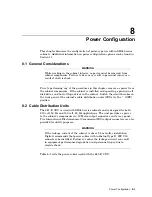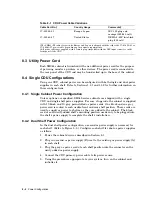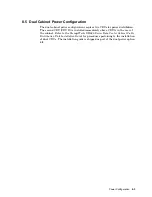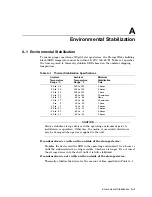
1. Move the cabinet away from adjacent enclosures as necessary.
2. Loosen the top cover by pushing up on its front and rear edges until it snaps
free of its fasteners.
WARNING
The top cover is heavy and awkward to lift. Removing it is a two-
person task. Failure to use sufficient personnel may result in injury or
equipment damage.
3. Using two persons, lift the top cover from the cabinet and set it aside.
4. Remove the bolts attaching the side panels to the top side rails of the cabinet.
5. Grasp a panel along its front and rear edges and lift up until the hanger clips
disengage. Lift the panel away from the cabinet.
6. Repeat the previous step to remove the other panel.
7.3 Chassis Rail Installation
To allow the length of the chassis rail to be adjusted to fit the cabinet, one end of
the rail is extendable using a sliding rail bracket. Two round standoffs are used
to locate the chassis rail along the vertical cabinet rails. The round standoffs are
inserted into front and rear chassis rail locating holes to position the chassis rail
while it is fastened to the cabinet.
Chassis rail component assembly and installation procedures for both left and
right tape drive mounting positions are presented in Sections 7.3.1, 7.3.2, and
7.3.3.
Note
Two small ESD grounding posts are provided with the cabinet. One is
located on a front vertical cabinet rail, and one on a rear rail. Should an
ESD grounding post interfere with the installation of the chassis rail,
move the post out of the way to any free hole on the cabinet.
7.3.1 Chassis Rail Assembly
Before the chassis rail components can be mounted in the cabinet, they must be
assembled. Assemble the chassis rail components as follows (see Figure 7–3):
1. Position the rail bracket against the chassis rail, as shown in the illustration.
2. Fasten the rail bracket to the chassis rail with the unbeveled nut bar and four
screws, as shown. Leave the screws loose enough to allow the rail bracket to
be moved along the chassis rail.
3. Install a U-nut in the groove near the end of each of the beveled nut bars.
The flat side of the U-nuts must be installed on the
beveled
side of the nut
bar.
4. Install the beveled nut bars on the chassis rail and rail bracket, using the
round standoffs to hold them in place. The beveled side of the nut bars must
face the flanges on the chassis rail and rail bracket.
7–4 Installing TZLX-Series Tape Drives
















































